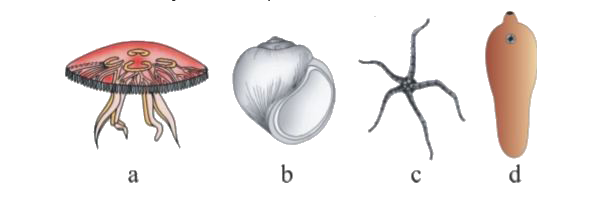Which one of the following is a radially symmetrical, blind sac body plan and diploblastic animal?
Spongilla
Euspongia
Asterias
Physalia
The correct Answer is:D
To solve the question "Which one of the following is a radially symmetrical, blind sac body plan and diploblastic animal?", we can follow these steps:
1. Understand the Terms:
- Radially Symmetrical: An organism is radially symmetrical if it can be divided into similar halves by multiple planes passing through the center.
- Blind Sac Body Plan: This refers to a body plan where there is a single opening that serves as both the mouth and the anus, leading to a gastrovascular cavity.
- Diploblastic: This means the organism develops from two germ layers: ectoderm and endoderm.
2. Evaluate the Options:
- Option 1: Spongilla: This is a freshwater sponge. Sponges are generally asymmetrical and do not fit the criteria of being radially symmetrical or diploblastic.
- Option 2: Uspongia: Similar to Spongilla, Uspongia (also known as "bath sponge") is asymmetrical and does not have a blind sac body plan.
- Option 3: Asterias: Asterias is a starfish, which exhibits radial symmetry. However, starfish are triploblastic (having three germ layers: ectoderm, mesoderm, and endoderm), so this option does not meet the criteria.
- Option 4: Physalia: Physalia, commonly known as the Portuguese man o' war, is radially symmetrical, has a blind sac body plan, and is considered diploblastic.
3. Conclusion:
- After evaluating all the options, the only organism that fits all the criteria of being radially symmetrical, having a blind sac body plan, and being diploblastic is Physalia.
Final Answer:
The correct answer is Option 4: Physalia.
---
- Radially Symmetrical: An organism is radially symmetrical if it can be divided into similar halves by multiple planes passing through the center.
- Blind Sac Body Plan: This refers to a body plan where there is a single opening that serves as both the mouth and the anus, leading to a gastrovascular cavity.
- Diploblastic: This means the organism develops from two germ layers: ectoderm and endoderm.
- Option 1: Spongilla: This is a freshwater sponge. Sponges are generally asymmetrical and do not fit the criteria of being radially symmetrical or diploblastic.
- Option 2: Uspongia: Similar to Spongilla, Uspongia (also known as "bath sponge") is asymmetrical and does not have a blind sac body plan.
- Option 3: Asterias: Asterias is a starfish, which exhibits radial symmetry. However, starfish are triploblastic (having three germ layers: ectoderm, mesoderm, and endoderm), so this option does not meet the criteria.
- Option 4: Physalia: Physalia, commonly known as the Portuguese man o' war, is radially symmetrical, has a blind sac body plan, and is considered diploblastic.
- After evaluating all the options, the only organism that fits all the criteria of being radially symmetrical, having a blind sac body plan, and being diploblastic is Physalia.
The correct answer is Option 4: Physalia.
Topper's Solved these Questions
- ANIMAL KINGDOMBOOK - MOTIONCHAPTER - ANIMAL KINGDOMEXERCISE - EXERCISE -2(NCERT Based Questions) ANALYTICAL QUESTIONS
20 Videos
- ANIMAL KINGDOMBOOK - MOTIONCHAPTER - ANIMAL KINGDOMEXERCISE - EXERCISE -3 (AIPMT & NEET Previous Year Questions) AIPMT - 2006
7 Videos
- ANIMAL KINGDOMBOOK - MOTIONCHAPTER - ANIMAL KINGDOMEXERCISE - EXERCISE -1(Objective Problems) CHORDATES
64 Videos
- ANATOMY OF FLOWERING PLANTSBOOK - MOTIONCHAPTER - ANATOMY OF FLOWERING PLANTSEXERCISE - Excercise - 4 AIIMS | Assertion & Reason Questions
34 Videos
- BIOLOGICAL CLASSIFICATIONBOOK - MOTIONCHAPTER - BIOLOGICAL CLASSIFICATIONEXERCISE - CHECK YOUR CONCEPTS-4
13 Videos
Similar Questions
Knowledge Check
Which one of the following is a radially symmetrical, blind sac body plan and diploblastic animal?
ASpongillaBEuspongiaCAsteriasDPhysaliaWhich of the following animals are radial symmetrical ?
 Aa & bBb & dCc & dDa & c
Aa & bBb & dCc & dDa & cWhich one of the following animal is radiallyl symmetrical.
ASyconBEuspongiaCAdamsiaDAll of the above
